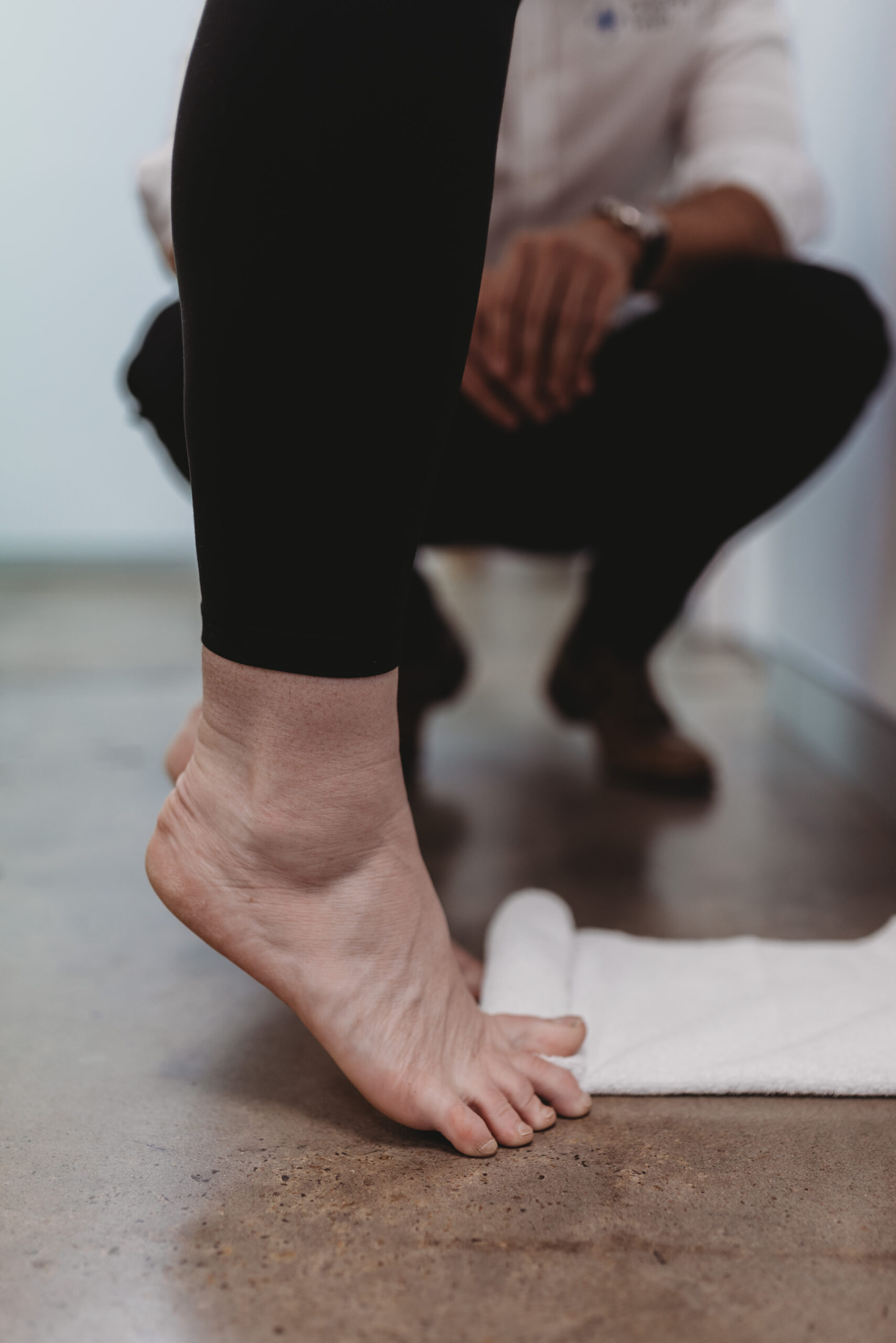Who is affected?
Plantar fasciitis is a condition that can affect individuals of various ages and lifestyles. It is most commonly seen in adults, particularly those between the ages of 40 and 60. However, it can also occur in younger individuals, including athletes and those who engage in activities that put repetitive stress on the feet.
Certain factors may increase the risk of developing plantar fasciitis, such as:
- Physical activities: People who participate in high-impact activities like running, dancing, or jumping are more prone to developing plantar fasciitis.
- Foot mechanics: Individuals with flat feet, high arches, or abnormal walking patterns may be at a higher risk.
- Obesity: Excess weight can put additional stress on the plantar fascia, increasing the likelihood of developing the condition.
- Occupations: Jobs that involve prolonged standing or walking on hard surfaces can contribute to the development of plantar fasciitis.
- Age and gender: As mentioned earlier, plantar fasciitis is more common in middle-aged individuals, and it tends to affect women more frequently than men.
It is important to note that while these factors may increase the risk, plantar fasciitis can still occur in individuals without any of these predisposing factors. If you suspect you have plantar fasciitis or are experiencing foot pain, it is recommended to consult with a healthcare professional for an accurate diagnosis and appropriate treatment.
Symptoms of plantar fasciitis
Plantar fasciitis is a common condition that causes pain and discomfort in the heel and bottom of the foot. The most common symptom of plantar fasciitis is heel pain, typically described as a sharp or stabbing sensation. Other symptoms may include:
- Pain that is worse in the morning: Many individuals with plantar fasciitis experience the most pain when taking their first steps after waking up or after prolonged periods of rest.
- Pain that improves with activity: While the pain may be intense initially, it often improves with movement and activity. However, it may worsen again after prolonged periods of standing or walking.
- Pain that worsens with certain activities: Activities that put stress on the plantar fascia, such as running, jumping, or climbing stairs, can exacerbate the pain.
- Tenderness or inflammation: The affected area may be tender to touch, and there may be swelling or redness in the heel.
- Stiffness or limited range of motion: Some individuals with plantar fasciitis may experience stiffness or difficulty flexing the foot, particularly in the morning or after periods of inactivity.
If you suspect you have plantar fasciitis or are experiencing persistent foot pain, it is recommended to consult with a healthcare professional for an accurate diagnosis and appropriate treatment options.
Treatment of plantar fasciitis
The treatment of plantar fasciitis typically involves a combination of conservative measures aimed at reducing pain and inflammation, promoting healing, and preventing further injury. Here are some common treatment options:
- Rest and activity modification: Avoid activities that worsen the pain and give your foot time to heal. Reduce or modify high-impact activities that put strain on the plantar fascia.
- Ice therapy: Apply ice packs to the affected area for about 15-20 minutes several times a day to help reduce pain and inflammation.
- Stretching and strengthening exercises: Perform specific exercises to stretch and strengthen the muscles and tendons in the foot and calf. This can help alleviate tension on the plantar fascia.
- Orthotic devices: Wearing supportive footwear or using orthotic inserts can provide cushioning and arch support, reducing strain on the plantar fascia.
- Nonsteroidal anti-inflammatory drugs (NSAIDs): Over-the-counter pain relievers like ibuprofen or naproxen sodium may help reduce pain and inflammation. However, it is important to consult with a healthcare professional before taking any medication.
- Physical therapy: A physical therapist can provide targeted treatments such as ultrasound therapy, massage, and exercises to help relieve pain and improve flexibility and strength.
- Night splints: Wearing a splint or brace overnight can help stretch the plantar fascia and Achilles tendon, reducing morning pain and stiffness.
In severe cases that do not respond to conservative treatments, other options like corticosteroid injections or extracorporeal shockwave therapy (ESWT) may be considered. It is important to consult with a healthcare professional for an accurate diagnosis and personalised treatment plan for plantar fasciitis.
Timeframes to recover from plantar fasciitis
The recovery timeframe for plantar fasciitis can vary depending on various factors, including the severity of the condition, individual healing abilities, and the chosen treatment approach. In general, it can take several weeks to several months for a full recovery from plantar fasciitis.
The initial phase of recovery typically involves reducing pain and inflammation. This may involve rest, avoiding activities that worsen the symptoms, applying ice, and taking over-the-counter pain medications as recommended by a healthcare professional.
Physical therapy exercises and stretches are often prescribed to improve flexibility and strength in the foot and calf muscles. Additionally, wearing supportive footwear or orthotic devices can help alleviate pressure on the plantar fascia. In some cases, additional treatments such as corticosteroid injections or extracorporeal shockwave therapy may be recommended by a healthcare professional.
It is important to note that plantar fasciitis recovery can be a gradual process, and it may require patience and consistency with treatment and self-care measures. It is advisable to consult with a healthcare professional for an accurate diagnosis and personalised treatment plan to address your specific condition.
Risk factors of developing plantar fasciitis
There are several risk factors that can increase the likelihood of developing plantar fasciitis. These include:
- Age: Plantar fasciitis commonly affects individuals between the ages of 40 and 60, although it can occur at any age.
- Physical activity: Engaging in activities that put repetitive stress on the feet, such as running, dancing, or jumping, can increase the risk of developing plantar fasciitis.
- Foot mechanics: Having certain foot mechanics, such as flat feet, high arches, or an abnormal walking pattern, can contribute to the development of plantar fasciitis.
- Obesity: Excess weight can put additional strain on the plantar fascia, increasing the risk of inflammation and injury.
- Occupational factors: Jobs that involve prolonged standing or walking on hard surfaces can increase the risk of developing plantar fasciitis.
- Improper footwear: Wearing shoes that lack proper arch support or cushioning can contribute to the development of plantar fasciitis.
- Tight calf muscles: Having tight calf muscles can put additional stress on the plantar fascia, increasing the risk of injury.
It’s important to note that while these factors can increase the risk of developing plantar fasciitis, they do not guarantee its occurrence. Taking preventive measures, such as wearing supportive footwear, maintaining a healthy weight, and properly stretching and strengthening the feet and calves, can help reduce the risk.
Physiotherapy in managing plantar fasciitis
Physiotherapy can play a significant role in managing plantar fasciitis, a condition characterised by inflammation and pain in the plantar fascia, a thick band of tissue that connects the heel to the toes. Here are some ways in which physiotherapy can help:
- Pain management: Physiotherapists can employ various techniques such as manual therapy, ultrasound, or electrical stimulation to help alleviate pain and reduce inflammation in the affected area.
- Stretching and strengthening exercises: Physiotherapists can prescribe specific exercises to stretch and strengthen the muscles and tissues surrounding the plantar fascia. These exercises can help improve flexibility, reduce strain on the fascia, and promote healing.
- Gait analysis and correction: Physiotherapists can assess your walking or running pattern to identify any abnormalities or imbalances that may contribute to plantar fasciitis. They can then provide guidance on proper footwear, orthotics, or modifications to your gait to reduce stress on the plantar fascia.
- Manual therapy techniques: Physiotherapists may use hands-on techniques such as massage, joint mobilisation, or myofascial release to improve tissue mobility, reduce muscle tension, and enhance overall foot function.
- Education and self-management strategies: Physiotherapists can educate you about plantar fasciitis, its causes, and ways to manage symptoms. They may provide advice on activity modification, footwear choices, and home exercises to promote self-management and prevent recurrence.
It is important to consult with a qualified physiotherapist who can assess your specific condition and develop a personalised treatment plan tailored to your needs. They will guide you through the appropriate exercises and techniques to effectively manage plantar fasciitis.
Here at OnePointHealth, we offer a range of services including physiotherapy, chiropractic care, massage therapy, podiatry, and exercise physiology. Our team are all qualified healthcare professionals who aim to provide personalised and evidence-based treatments to help individuals recover from injuries, manage chronic conditions, and improve overall health.












